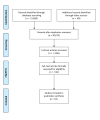Adult consequences of late adolescent alcohol consumption: a systematic review of cohort studies
- PMID: 21346802
- PMCID: PMC3035611
- DOI: 10.1371/journal.pmed.1000413
Adult consequences of late adolescent alcohol consumption: a systematic review of cohort studies
Abstract
Background: Although important to public policy, there have been no rigorous evidence syntheses of the long-term consequences of late adolescent drinking.
Methods and findings: This systematic review summarises evidence from general population cohort studies of drinking between 15-19 years old and any subsequent outcomes aged 20 or greater, with at least 3 years of follow-up study. Fifty-four studies were included, of which 35 were assessed to be vulnerable to bias and/or confounding. The principal findings are: (1) There is consistent evidence that higher alcohol consumption in late adolescence continues into adulthood and is also associated with alcohol problems including dependence; (2) Although a number of studies suggest links to adult physical and mental health and social consequences, existing evidence is of insufficient quality to warrant causal inferences at this stage.
Conclusions: There is an urgent need for high quality long-term prospective cohort studies in order to better understand the public health burden that is consequent on late adolescent drinking, both in relation to adult drinking and more broadly. Reducing drinking during late adolescence is likely to be important for preventing long-term adverse consequences as well as protecting against more immediate harms. Please see later in the article for the Editors' Summary.
Conflict of interest statement
The authors have declared that no competing interests exist.
References
-
- Rehm J, Mathers C, Popova S, Thavorncharoensap M, Teerawattananon Y, et al. Global burden of disease and injury and economic cost attributable to alcohol use and alcohol-use disorders. Lancet. 2009;373:2223–2233. - PubMed
-
- Department of Health. London: Alcohol Policy Team; 2007. Safe. Sensible. Social. The next steps in the National Alcohol Strategy-a summary.
-
- Johnstone BM, Leino EV, Ager CR, Ferrer H, Middleton-Fillmore K. Determinants of life-course variation in the frequency of alcohol consumption: Meta-analysis of studies from the collaborative alcohol-related longitudinal project. J Stud Alcohol. 1996;57:494–506. - PubMed
-
- McCarty CA, Ebel BE, Garrison MM, Di Giuseppe DL, Christakis DA, et al. Continuity of binge and harmful drinking from late adolescence to early adulthood. Pediatrics. 2004;114:714–719. - PubMed
-
- Patton GC, Coffey C, Sawyer SM, Viner RM, Haller DM, et al. Global patterns of mortality in young people: a systematic analysis of population health data. Lancet. 2009;374:881–892. - PubMed
Publication types
MeSH terms
LinkOut - more resources
Full Text Sources
Medical


